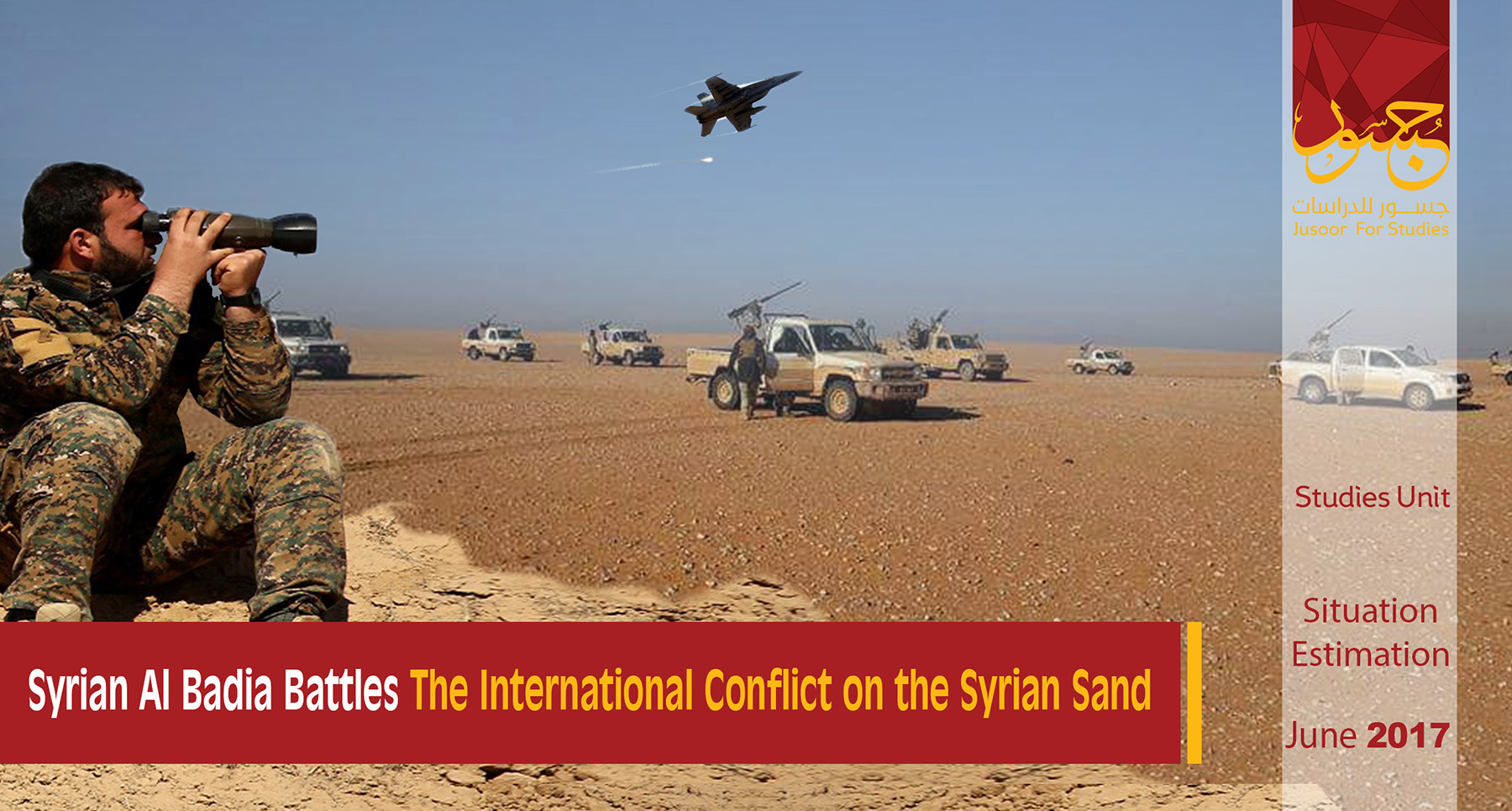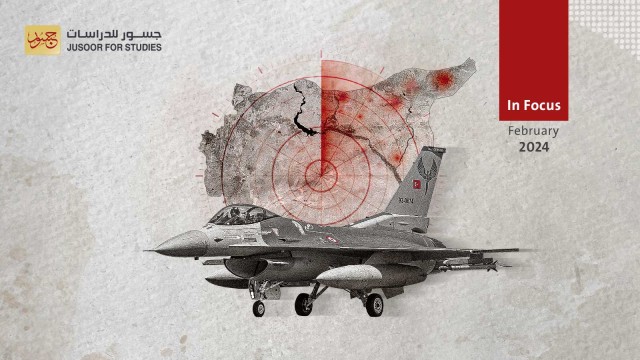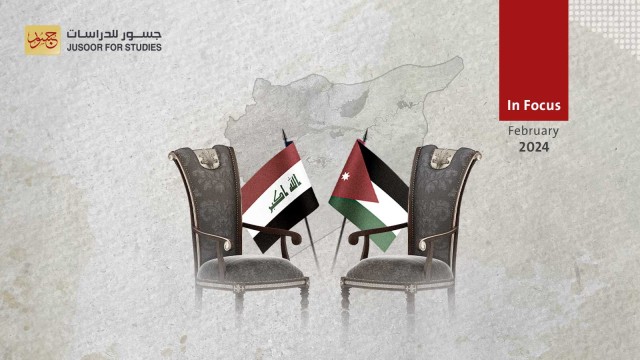Syrian Al Badia Battles The International Conflict on the Syrian Sand
The Scene Realities
Syrian regime forces baked by Iranian militias are trying to increase their control in Al Badia as the Syrian opposition tries to advance in regions controlled by ISIS in Al Badia which runs from eastern Qalamoun, east of Damascus rural to the center of Syria in Palmyra in the eastern country side of Homs to the north of Syria near the outskirts of Deir ez-Zor Governorate.
The recent confrontations did not aim to undermine ISIS influence only, but also included the regions controlled by the Syrian opposition, as the regime forces backed by Iranian militias have tried to advance through Al Tanf crossing. Al Tanf crossing is the breaking point between the Syrian regime and the opposition factions as per the De-escalation zones agreement. Jaysh Usud al-Sharqiya and the Revolutionary Commando Army are the most notable factions in that region.
The most import development was the American air strikes against the Syrian regime forces and the militia’s supporting the regime, which occurred three times in less than a month.
On the 18/5/2017 American military aircrafts targeted a military convoy belonging to the Syrian regime after it ignored many warnings from the US-led coalition to not come close to a military base adjacent to Al Tanf crossing, where opposition factions along with American, British, and Norwegian consultants are stationed. The convoy was destroyed by the US-led coalition airstrike, as sources from the Syrian regime stated that: “the strike was a warning one and led to destroying a tank”. Other sources confirmed that the strike caused casualties in the military convoy (1), on the 18/5/2017.
Forces thought to be Iranian militias accompanied with an officer from the Syrian army tried to pass through the road between Al-Sabe' Biyar and Zaza checkpoint which are included in the de-escalation zones, to reach Al Tanf military base. These forces included a military unit which comprised of one tank, cannons, AA defenses, military vehicles, and more than 60 soldiers. The U.S sent warnings to Russia through the military hot line and the Russians did not respond. The American aircrafts then bombed this military unit destroying two cannons, one AA defense, and a tank on 6/6/2017. Later, the Syrian Observatory for Human Rights confirmed that 32 soldiers including one Syrian officer and one Syrian soldier from the Syrian Army (2) were killed by the strike.
On the 8/6/2017, the US-led coalition shot down an unmanned aircraft belonging to the regime after it launched strikes against troops belonging to the coalition without causing any casualties. Colonel Ryan Dillon, an American official in the international coalition, indicated that, “the Syrian drone intended to attack the coalition forces without sending any warnings which posed a threat to the coalition forces and is an act of hostility”. He also added that: “U.S carried out strikes against trucks with weapons that were moving towards the combatants backed by America near Al Tanf town”.
Other American official declared that: “the missile landed near the coalition forces without exploding, and F-15 aircraft shot down the drone, which is likely to have been made in Iran. However, more inspection and analyses of this drone are still taking place (3)”.
The Syrian regime denounced these air raids while the Syrian Foreign Ministry warned the international coalition of the consequences of such an escalation, demanding from the U.S and the international coalition to stop targeting the Syrian Army (4).
United States Secretary of Defence James Mattis, declared that the military unit targeted by the coalition on the 19th of May was commanded by the Iranians(5). This led the Iranian-affiliated militias to respond by issuing a statement in the name of “Syria’s Allied Forces” that said: “the American hostile act under the name -the coalition against terrorism- is a dangerous and reckless one that shows U.S deception and Hypocrisy in confronting terrorism. America must know that the blood of Syrians and their allies are not worthless and the targeting of the Syrian Army’s points of concentration at any time will not be tolerated (6)”.
The situation in Al Badia is not limited to air raids against the Syrian regime and its allies, but is connected to the situation inside Iraq. Forces from the Iraqi popular mobilization are being deployed on the Syrian-Iraqi boarders in order to increase the pressure against ISIS, along with protecting the boarders from any infiltration by the terrorist organization’s combatants.
This issue raised concerns for many sides about the possibility of the popular mobilization forces intervening and taking part in the Al Badia battles alongside the regime’s forces, as these forces have constantly been accused of sectarian acts. According to Abu Azrael, a commander in the popular mobilization forces “these acts became a source of pride”. (7)”.
In the South of Syria, the regime deployed many of its forces in Daraa Governorate, viewing the battle in Daraa against the Syrian opposition as an extension of the Al Badia Battle. The regime’s forces seeks to advance horizontally from different axes in order to expand its military influence within the map of military influence.(8)
The objectives of the popular mobilization forces could be hindered by the international coalition’s fight against terrorism which will prevent the pro-government forces backed by Iranian and sectarian militias from controlling the Al Tanf triangle that links Jordan, Syria, and Iraq.
Syria’s minster of defense Fahd Jassem al-Freij, declared the end of the first phase of military operations in Al Badia after reaching the Iraqi boarders on the 10/6/2017. He added that, the Syrian regime has since the beginning of the military operations controlled 20000 KM2 in south and east of Palmyra, considering these gains a strategic achievement for the regime in its “war against terrorism”. He also stressed the ability of the Syrian Army and its allies in fighting terrorism describing it as the only effective force in Syria, and warned of the risks of what he referred to as the international coalition’s hostilities(9).
Second: Escalation’s Indications
Until the day this report was issued, the realities on the ground show that the pro-government forces and their allies have not reached the Syrian-Iraqi boarders, as there is still 15 KM which is largely under the control of ISIS.
Moreover, the realities on the ground show that the regime’s forces are advancing in areas under the control of ISIS rather than the areas controlled by the Syrian opposition, and is 45 KM far from the boarders of the east of Al Tanf crossing which is a sandy area unsuitable for transmitting vehicles.
This indicates the Syrian regime does not seek to open the Damascus-Baghdad international road that goes through Al Tanf crossing, which is under the control of the US.
Furthermore The Syrian regime’s complete control of Al Badia is hypothetical because it’s unable to deploy its forces all over the desert, and thus the Syrian opposition or ISIS can recapture these areas through limited battles against small military groups of the Syrian Army on some hills within extensive regions.
It’s worth mentioning that, the control of Al Badia by any side does not mean hindering the movement of other groups, unless a robust aerial surveillance takes place. The Syrian opposition was able to pass constantly in Al Badia when it was under the regime’s control. For instant’s, Zahran Alloush, the former commander of Jaysh al-Islam was able to move from Duma to Turkey through Al Badia, for a visit and returned back in April 2015, when in theory it was under the regime’s control at the time.
In the short term, the regime’s announcement that it has reached the Iraqi boarders is considered a political and local achievement, where Al Assad can emerge as the main actor in the region with the ability to execute military strategies besieging the American military base without taking into account the international coalition forces.
Iran is trying to exceed the American redlines through its militias frequent attempts to reach Al Tanf crossing from different axes.
Moreover, another test for the American redlines comes with the advancement of the popular mobilization forces towards the Syrian-Iraqi boarders and threatening to enter Syria.
The direct geographical correlation between Damascus, Baghdad, and Beirut is a strategic objective for Tehran, and consequently Iran can fight to fulfill this goal just like it did in Homs and Damascus western’ rural. Iran’s military strategy did not focus on securing this road which has become unsafe since 2012. However the recent geopolitical changes and the possibilities of what may happen after the Ar-Raqqa and Deir ez-Zor battles, led Tehran to change its priority, taking advantage of the calm situation from the De-escalation agreement.
As for US-led coalition, its main objective is protecting the military base in Al Tanf. The Syrian regime’s formal progress doesn’t pose a real threat for the coalition, as it can eliminate the presence of the regime at any time, it poses a threat to the U.S-forces or the International coalition itself.
Russia is seeking the role of mediator between the American and Iranian sides in order to reach an agreed formula between the two sides. The American side commended the Russian role in preventing any threat against Al Tanf base(10). The American and Russian sides are conducting negotiations that include special arrangements for the southern and eastern regions. These negotiations may lead to an agreement concerning the delamination of Al Badia and Daraa Governorate’s map of influence.
Third: The Anticipated Scenarios
In the meantime, the battle of Syrian Desert has two main possibilities:
First: The Syrian regime and its allies will start the second phase of Al badia Battle by controlling Al Sukhna city near Palmyra in Homs eastern rural, after receiving support from Moscow since it has troops deployed in Palmyra. Controlling Al Sukhna will secure the outskirts of Palmyra and expand the regime’s military defenses which protects Russia’s influence in the region.
The second phase of Al Badia Battle may witness the expansion of the regime’s influence in Daraa Governorate due to its linkage with As-Suwayda’s rural battles where the Syrian opposition is trying to advance through the country side.
The possibilities of making more progress by the opposition could be reduced despite the constant attempts of weakening the Syrian regime in As-Suwayda rural and eastern Damascus rural. However, the latter will try to control Al Sukhna or even the southern rural of Ar-Raqqa and Deir ez-Zor, while defending its areas in As-Suwayda and Damascus rural.
Second: the Syrian opposition could continue advancing in As-Suwayda and Damascus rural starting from Al Tanf in the direction of Palmyra, as the opposition declared the start of “this is our land” battle in order to contain the progress made by the Syrian regime in the past few days(11). They will seek to cut off the road between Damascus and Baghdad which brings the regime back to square one in Al Badia. Moreover, the pressure on the regime from the opposition in As-Suwayda hinders the former’s advancement towards Al Sukhna or even Deir ez-Zor and Ar-Raqqa rural.
Third: The American and Russian sides reach an agreement on dividing their influence in Al Badia region for the sake of avoiding any intersection between the military tracks of the Syrian opposition backed by U.S and the Syrian regime backed by Russia and Iran in that region. In this scenario, the conflict between the Syrian regime and opposition will take place in regions that are not included in the agreement.
Tehran will try to reach Al Tanf base as a part of its policy in testing the American redlines. The above-mentioned agreement will separate the Iranian forces and American forces alongside the Syrian opposition factions which provides an opportunity for the Syrian regime to mobilize away from American targets.
Margins:
(1) “Commander: US-led coalition airstrike tried to prevent the progress toward Al Tanf Base” Reuters, 18/5/2017.
- “Syrian military source: the American strike targeted a military point”. Reuters, 19/5/2017.
(2) “America attacks pro-government forces once again after sending warnings” Reuters, 7/6/2017.
- “An increase in the casualties of the targeted military column from 32 to 140 after being struck with four air raids”. Syrian Observatory for Human Rights, 8/6/2017
(3) “Spokesperson: America shot down a drone related to the Syrian regime allies” Reuters, 8/6/2017.
(4)“The Ministry of Foreign: US-led coalition is conducting terrorist acts and violates the international law along with the Security Council decisions”, SANA, 7/6/2017
(5) Jim Matis assumed that the military convoy was led by Iranian commander. Al Jazeera Net, 19/6/2017.
(6) “Alliance related to Al Assad forces threatens to strike American posts in Syria”. Reuters, 7/6/2017.
(7) “Video…. Abu Azrael reaches the Syrian boarders…. What did he declare?” Orient Net, 30/5/2017
(8) “Military mobilizations to cut off the road between Daraa city and its eastern rural”. Al Hayat Journal, 12/6/2017
(9) A statement from the overall command of the Syrian Army and the armed forces about reaching the Iraqi boarders, SANA, 10/6/2017
(10) “Pentagon: Russia is very cooperative in the De-escalation south of Syria”. Reuters, 9/6/2017
(11) “Rebels continue the Battle (this is our land) in Syrian Al Badia”. All4Syria, 6/6/2017








